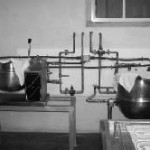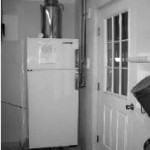Worcester Dairy Resumes Raw Milk Sales
August 17, 2007Have a Dexter Dairy Cow
September 30, 2007by Rose Marie Belforti
After two years of very intense planning, endless paperwork and protracted construction,
we finally have a small dairy and are making raw milk cheese—actually kefir cheese. After
working extremely closely with our New York State Agriculture and Markets Milk Division
on rules and regulations for building a dairy, we received our legal producer status this past November, 2006.
FUNDING
It has been a long haul, with many ups and downs. For funding to build our cheese processing plant, we applied for a Sustainable Agriculture Research and Education (SARE) producers’ grant in 2005. After some difficulty, we finally got approval in July of 2006. The SARE regional office thought our grant proposal was excellent. This put us on cloud nine!
But the proposal was then passed along for final approval to the larger US review team, and we were bumped off that cloud very quickly when the team notified us that the grant was denied because we wanted to make cheese with raw milk. We had an anxious four-month waiting period while the committee gave more consideration to the project. During that time I brought to their attention the fact that they had never mentioned any exclusions of any products in their proposal instructions. Since there was no mention of raw milk projects being disqualified, they ultimately had to approve the grant. So we did receive the funding, but I noticed that when they publicized the winners, our project was excluded from the publicity.
BUILDING THE DAIRY
We did not have a previous dairy building on our property so we had to start from scratch, from designing the ditching and waste control, to placement of the milk parlor, milk cool room, holding area for the cows and the cheese making room. There is a very big learning curve to starting a dairy for those of us with no previous experience. Each step of the way we consulted with the state inspectors concerning our building plans. It is better to get it right the first time than to have to go back and do it again.
The plan was to upscale a home recipe to a commercial process for an aged, raw milk kefir cheese using authentic living kefir grains. In cooperation with the Cornell University Food Processing and Development Laboratory, we set out to establish a standard for the new kefir cheese. We are very fortunate to have the expertise at Cornell to help put our new recipe together. Actually, I received very little resistance to either the raw milk or the use of kefir grains. I was pleasantly surprised at the support we got from Cornell. Although there is not a lot of support in general for raw milk products, folks in the business seem to be coming into a new awareness that small scale, unique, niche-market dairy ideas may eventually become part of mainstream agriculture, which fuels the economy of many dairy states.

Cheese processing plant, thanks to a Sustainable Agriculture Research and Education (SARE) producers’ grant.
Since we were on a budget, we had to scavenge to build the dairy and processing plant. Our $10,000 SARE grant covered everything I set out to do with the processing plant but not any operational or facility upgrade projects. We purchased a 1940s surge milking machine and assembled the entire unit from new and used parts we acquired from retired dairies in the area. The equipment we needed for the milk cooling room and the cheese room took an entire year to assemble because many of the things needed were just not readily available. With the help of some small dairy equipment dealers and eBay, we managed to put it all together under close scrutiny of the inspectors. State inspectors can be difficult. At first I had a really tough one, but now have a reasonable inspector. It is the rules and regs they enforce that are so difficult to deal with. They are not written for small farmers with very small facilities, or doing hand-milking, but for large dairies. This makes it very difficult for us small farmers because the cost of doing business becomes almost prohibitive.
Nevertheless, we were determined to go forward, even on our very small scale. We often had to improvise. For example, we use a refrigerator for a bulk tank— with such a small amount of milk it works just fine. In order to get our milk cooled down to 45 degrees within two hours, we put it in the freezer and then move it down to the fridge when it achieves the 45 degrees. How quaint!
In the cheese room we are using two refrigerators to age the cheese, and will have to plan for a bigger aging space this coming summer. We have two very old jacketed steam kettles that we use for warming the milk to start the kefir culture. The kettles have been converted to hot water. We were very blessed to have ingenious plumbers, who designed a system even though they had no clue about it when they started. But they were inspired to plumb a tiny cheese factory, something they had never done before.
Once built, getting to know the correct sanitation procedures has been the biggest challenge. Clean has a new meaning! We call it “the art of cleaning.” We have manuals to follow which means we end up sanitizing everything all the time! Most of my time is spent cleaning, not making cheese.
FROM FARM TO CREAMERY
Once we were ready for production, we changed our name from Finger Lakes Dexter Cattle to Finger Lakes Dexter Creamery. Our farm consists of twelve acres, with about seven acres for pasture, in the Finger Lakes region of New York on the east side of Cayuga Lake. We are one mile off the Scenic Route 90 Wine Trail and hope that our location will attract tourists who are here for the culinary delights the area has to offer.
The other very exciting aspect of our new venture is our brand new cheese, something never before produced commercially. We use full cream milk for our cheese and age it for 60 days or more. With
Dexter milk that means a lot of luscious, rich cream. Our new cheese is called Wild Man kefir cheese and first sold in the spring of 2007.
We originally started handmilking one cow. Now there are three. We are still milking by hand and love the relationship with our cows, but will have to begin using the milking machine this spring when we add one more cow to the operation. We plan to milk a maximum of six cows.
We plan to sell the cheese for eighteen dollars a pound through our website and at local retail stores. Check out our website at kefircheese.com/micro-dairy for
retail outlets that carry it. You will also be able to taste our cheese at the upcoming conference of the Weston A. Price Foundation.
So the whole process will have taken over two years, from grant proposal to cheese ready for sale. We hope to inspire other small producers to get into cheese making. If we can do it, so can many others!
Sidebar
KEFIR GRAINS
Kefir grains are a mixture of living microbial lactic bacteria and yeasts. They have been used by traditional peoples for centuries to make a cultured milk that promotes good health and longevity. Kefir grains propagate naturally when immersed in milk, making them an ideal sustainable natural resource. They have been nurtured and passed down for
generations and recently have become available in the US. Although there are many kefir products on the market, most are not made with kefir grains and do not include the unique array of beneficial probiotic bacteria inherent in the grains.
If you are interested in using kefir grains for home use, please visit our website at www.kefircheese.com and go to our links page. There you will find “Dom’s Kefir Site” and you can learn all you ever wanted to know and then some from Dom—the website is wonderfully informative and fun.
See also Rose Marie’s article on their Dexter dairy cows.
This article appeared in the Fall 2007 edition of Wise Traditions, the quarterly journal of the Weston A. Price Foundation.




4 Comments
I am with the rest of you.. small upstart farmer, loads of kefir grains.. and have been culturing with them for over 15 years. I have always wanted to do this. Congrats to you sir! I actually spoke today to the NC Ag Dairy Compliance officer and she had no clue that cheese could be made from kefir. She wanted me to send her everything I knew of about it and the process.. ( Im so not doing that 🙂 ) I guess if the laws and regs are not achievable here.. I will continue to just teach people about the wholesomeness of the grains and their abilities. Your website and Doms is very inspiring.. Thank you both.
JB
please give me some idea on how to start a cheese factory and the requirements
I’m so inspired by your journey through the cheese world, I someday hope to join the club and with this piece there is no turning back.
Thank you all for your comments! My kefir cheese email was hacked in 2017. Just catching up now. New email is: himmelhaus92@gmail.com
Very sorry for not responding!!!
Rose